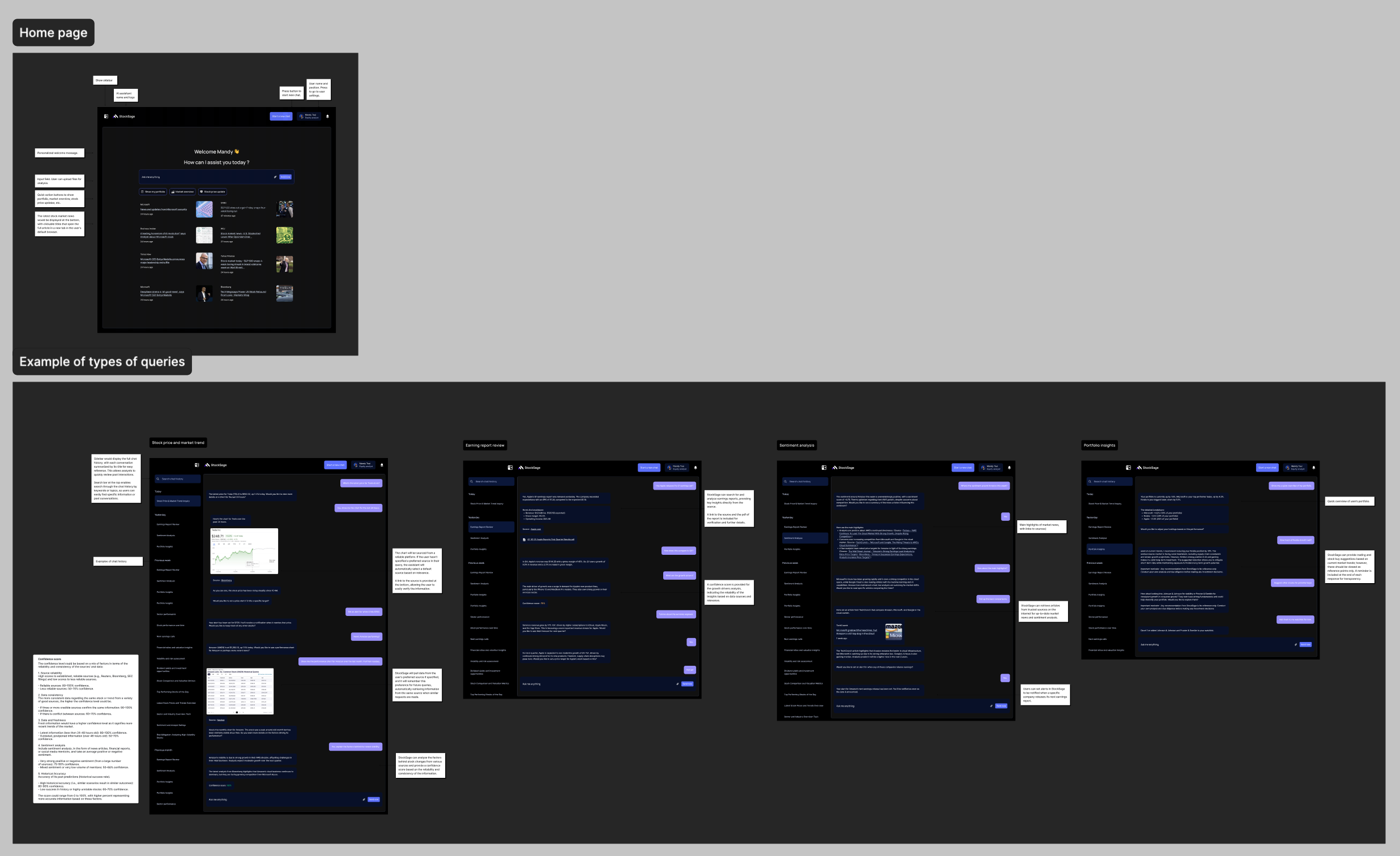

This idea came about through casual conversations with friends who work as buy-side and sell-side analysts. In discussing with them, I discovered that analysts traditionally use a number of platforms such as Bloomberg, Reuters, SEC filings, and Excel to retrieve market data, financial news, and company performance metrics. This led me to think: Would an AI chatbot be able to simplify this process and provide them with the insights they require more quickly?
Equity analysts primarily focus on stock valuations, earnings reports, and market trends. Their job requires them to have quick access to real-time market data, financial news, and company performance reports in order to make informed investment decisions.
In their daily work, analysts typically track market trends, analyze company financials, assess risk factors, and summarize their findings into reports for investors or internal teams. However, the tools they rely on are scattered across different platforms, making the process far from efficient. For instance, they might use Bloomberg Terminal for real-time stock data, FactSet or S&P Capital IQ for company financials, Excel for financial modeling and analysis, platforms like SEC EDGAR for official filings and Tableau for data visualization. While these tools are powerful, switching between them throughout the day can be a major bottleneck in their workflow.
Summary of common tools used :
For market data and news :
Financial modeling and analysis :
Earnings reports & filings
Through my research, a few major pain points emerged. Analysts are overwhelmed by the sheer volume of information they need to process and often waste time sifting through reports to find the data they need. The speed at which the market moves also adds pressure, as delays in accessing timely data can lead to missed opportunities.
Moreover, with scattered tools, analysts have to constantly switch between different platforms, which disrupts their flow and productivity. Manual reporting also eats up a significant portion of their time, as writing up financial summaries is a repetitive task.
I learned that what analysts really need is a way to quickly access and act on data without all the back-and-forth between platforms. They need fast, accurate insights and a system that understands their context and provides relevant information without them having to ask for it repeatedly. Analysts also need to be able to trust the data they are working with, and many of the existing systems don’t offer the transparency or context they require to feel confident in their decisions.
To make the assistant effective, I realized it needed to pull from key data sources that analysts rely on daily. These include real-time market data like stock prices and indices, company financials such as SEC filings and earnings reports, and financial news combined with sentiment analysis.
Incorporating these data sources into the AI assistant would ensure that analysts receive timely, relevant insights in a way that’s intuitive and fast. The chatbot’s primary function would be to streamline their workflow, cut through the noise of information overload, and present them with only the most useful, contextually relevant data when they need it. This would ultimately help analysts save time, reduce the fragmentation of their work, and make more informed decisions faster.
After pinpointing the problems, I defined the goal of the assistant : to provide a smarter, faster way for equity analysts to access key financial data. The chatbot had to be able to process both structured and casual questions, retrieve accurate data quickly, and remember past queries to provide relevant follow-up insights. The goal was for it to feel like a smart assistant that anticipates user’s needs and delivers insights without delay.
I envisioned for some basic features that could address the issues :
Quick data retrieval : Analysts must be able to get current stock prices, market trends, and earnings reports easily.
Natural language interpretation : The chatbot needs to understand formal financial jargon as well as casual, everyday queries.
Contextual recall : The bot needs to remember past questions and provide related information without repeating questions.
Data openness : Analysts need to be able to rely on the data they are getting, so openness about the data source and confidence levels were crucial.
Once I had a clear idea of the chatbot’s key features, I began the design phase. The biggest challenge here was making sure the interface was simple but functional. I wanted the chatbot to feel like a smart assistant rather than just a tool, and the interface needed to be clean, intuitive, and fast to use, so analysts could get to the data they needed with minimal friction.
I went with a chat interface that offered quick-action buttons for things like “Market Overview” or “Stock Price Update.” I kept the design minimalistic, just enough to make navigation intuitive without overwhelming the user. The color palette was professional, with purple accents to evoke trust and reliability.
The next step was to focus on how the user would interact with the chatbot. I wanted to ensure that the experience was as seamless and flexible as possible, so analysts could ask questions in a way that felt natural to them.
The user flow was designed to guide analysts through their inquiries. For example, when they first open the chatbot, they see options like "Show my portfolio" or "Stock price update", clear, actionable prompts to get started. But I also made it flexible enough so that even if an analyst typed something more open-ended, like “How’s the market today?” the chatbot would still understand and respond appropriately.
I also ensured that the chatbot would retain context. If an analyst asked about Amazon’s stock price and later followed up with a question like, “What’s the trend for the past week?” the bot would remember the earlier question and give a relevant answer without them needing to repeat themselves. This added a layer of conversational flow and would make the interaction feel more natural.
I decided to call the assistant "StockSage". The name is a portmanteau of "stock" (for financial data) and "sage," which reflects wisdom and experience.
StockSage would benefit equity analysts by :
✅ Convenient access to financial data : Real-time market data, stock news, and financial reports would be easily accessible.
✅ Natural, intuitive querying : Analysts would be able to ask questions naturally, rather than having to write formal search queries.
✅ Data trust : Each piece of data would be linked to its source, with levels of confidence for its trustworthiness.
The chatbot would provide real-time stock updates, portfolio summaries, and market insights, with clear visualizations. It would handle both simple and complex queries, remembering previous interactions for a smooth experience. The minimal interface would make it easy for analysts to switch between tasks.

If this project were to move into real development, there are several key challenges I would need to address.
Data Integration and reliability
One of the main challenges would be ensuring seamless integration of real-time data from trusted sources like Bloomberg, Reuters, and SEC filings. This would require building reliable API connections and continuous data validation to ensure we’re pulling the most accurate and up-to-date information.
Data security
Security would be a huge concern, especially since the platform would be handling sensitive financial data. Having effective encryption, GDPR-compliant privacy regulation, and the proper data protection mechanisms in place would be imperative in safeguarding trust among the users.
Scalability
As additional users become a part of the platform, the system would have to support higher data volumes as well as increased traffic. Extended infrastructure planning would be required to make sure that the system is scalable, responsive, and efficient even at peak usage times.
User trust
Creating trust among users would be essential, as financial information and decisions are private in nature. Having clean, trustworthy data sources with confidence scores and a smooth user experience would be paramount to making users feel comfortable to trust the tool.
Compliance with financial regulations
The financial industry is highly regulated, and therefore it would be important to make sure that the tool is compliant with financial regulations in terms of the use of data and advice. There would be periodic legal reviews needed to cut down on any compliance risks.
AI training and maintenance
Since the tool would rely on AI for giving insight, it would need to be updated periodically with new market data and user feedback. This would mean continuous training and fine-tuning so that the AI is accurate, efficient, and useful for users.
Since this is a personal project, I didn’t go into development or testing. If this were a live project, here’s what I would focus on next :
1. Development
I would work closely with developers and ensure that the chatbot is powered by a robust AI engine that can pull in financial data from reliable sources. The AI would need to be trained to understand both technical financial terms and casual queries. Integration with platforms like Bloomberg, Reuters, and SEC filings would be crucial for real-time data.
2. User testing
Once the chatbot was built, I would move into the testing phase. I would gather feedback from analysts in real-world scenarios to see how well the bot meets their needs. Are they able to get the insights they need quickly? Is the bot intuitive to use? Does it make their workflow easier or more efficient? Based on feedback, I would make adjustments and improve the chatbot’s capabilities.
3. Iteration
With user feedback, I would then iterate on the design to address any pain points that arose. If the bot’s responses were not clear or if certain features were not as useful as expected, I would refine the UI and interaction flow to enhance the user experience. The goal would be to keep improving the bot’s ability to predict and respond to analyst needs in a way that reduces friction and saves time.